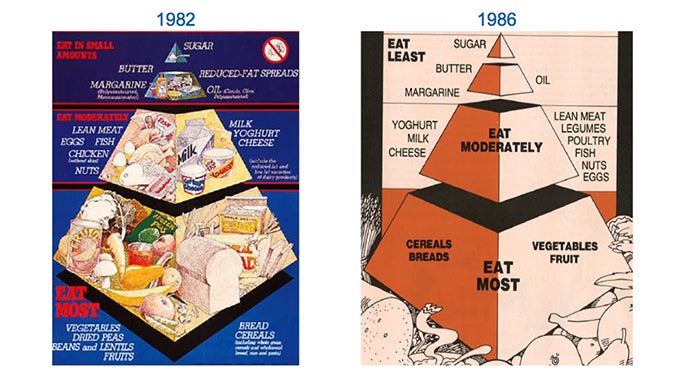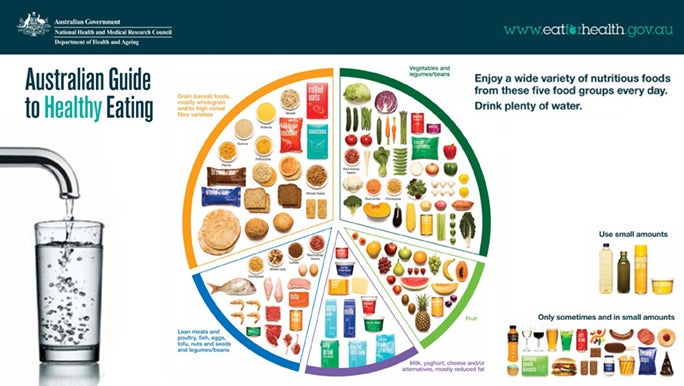Anyone who grew up in Australia since the 1980s knows exactly what a food pyramid is. It’s reminiscent of primary school visits to the Healthy Harold van, or your childhood doctor’s waiting room.
Many of us know that the structure, carb heavy at the bottom and topped with pink wrapped lollies, is now outdated. What many don’t know is – what replaced the food pyramid?
The Australian healthy eating pyramid
Nutrition Australia first developed the Healthy Eating Pyramid in 1982, based on what we knew about dietary requirements in the 1980s. A time where fat was perceived to be the enemy and we could all, guilt free, binge on pasta to our heart’s content.
This model put carbohydrates, fruit and veggies as the main component of a healthy diet. The images represented sliced bread and pasta alongside grains and other whole foods.
It was used as the predominant guide for the next 30 odd years, in one form or another.
The model changed throughout the years to reflect the constantly evolving dietary requirements that came with each decade. And although the Australian government is no longer using a pyramid model, there are still many associations that use similar, but more refined, visual guides.
Strengths and weaknesses of the healthy eating pyramid
We talked to Shivaun Conn, Accredited Practising Dietitian and Accredited Nutritionist, about her thoughts on the Australian food pyramid.
“So I actually think the pyramid was really consumer friendly, people related to it and it was simple to understand.”
The greatest strength, and weakness of this model though, was the same thing: simplicity.
While it was easy to understand – and follow – the original pyramid had only three layers:
- eat most – cereals, breads, vegetables and fruit
- eat moderately – dairy and proteins
- eat in small amounts – butter, margarine and other fats, and sugar

Nutrition Australia first developed the Healthy Eating Pyramid in 1982, based on what we knew about dietary requirements in the 1980s.
This structure was easy to understand, simple to communicate and visually appealing (well, to us in the 80s). All of those factors made it a perfect marketing campaign. Aussies embraced it wholeheartedly. And why wouldn’t they? Mashed potatoes and meat with a scoop of ice cream for dinner, what’s not to love?
While the original food pyramid isn’t entirely wrong, it was overly simplified – and that meant that the information wasn’t entirely correct.
We now know the effects processing has on the nutritional value of grains, but also how it impacts other foods.
Modern recommendations put a much higher emphasis on vegetables than processed grains, and whole foods/grains than processed. And unfortunately, we also know that eating a balanced diet is a bit more complicated than this model suggested. Portion sizes are just one of the important details that the pyramid failed to address.
Some organisations, such as Nutrition Australia, still use a pyramid model (which looks much nicer than the one above). But a highly detailed and updated version of the same idea. Sugar has been replaced by healthy fats, and unhealthy options are pictured beside the pyramid.
“The reason they took them out is because we don’t need them. They shouldn't really be part of what we're recommending. Sure, they're to the side because you can have them occasionally as part of a balanced diet,” says Shivaun.

Modern recommendations put a much higher emphasis on vegetables than processed grains, and whole foods/grains than processed.
What replaced the food pyramid?
Now, the Australian Government guidelines use a plate model that focuses on 5 food groups:
- grains (cereal) foods, mostly wholegrain and/or high cereal high fibre varieties
- vegetables and legumes/beans
- lean meats, poultry, fish, eggs, tofu, nuts and seeds
- milk, yoghurt, cheese and/or alternatives, mostly reduced fat
- fruit
There is also a side category with wine, sweets, junk food, cream, spreads, oils and processed meats called ‘only sometimes and in small amounts.’ Although, it’s worth noting that these guidelines are under review and new ones will be released in 2025.

Unfortunately the ‘plate’ model hasn’t taken off as well as the pyramid, even though it has been in use since 2013.
Unfortunately the ‘plate’ model hasn’t taken off as well as the pyramid, even though it has been in use since 2013. Shivaun believes that this is because people don’t understand it well.
“It's got the whole five food groups on one plate and that makes people ask, oh, do we do that every meal? Do I always have to put fruit and dairy on there? I actually think there’s a lot of room for more public education on how to use this tool to make positive changes to their diets,” she says.
Another reason the healthy eating plate may not be used that widely is because for many Aussie families eating off plates is only happening for one meal a day.
Many children eat breakfast at preschool, before school care or in transit – and we tend to snack between meals also.
Often, we are preparing lunch boxes more than plates and buying pre-prepared food more than cooking. Parents especially may feel overwhelmed with the amount of food represented in the diagram – especially if their children are fussy eaters.

Check out the Australian Dietary Guidelines for information on daily nutrition needs for kids and adults.
It’s actually pretty simple according to Shivaun. She says “Most dietitians will recommend you try to get grains, veggies and protein for lunch and dinner and then snack on some fruit and calcium-rich foods throughout the day. Then, breakfast can make up the difference.”
The Australian Dietary Guidelines provides information on daily nutrition needs for kids and adults as there are different recommendations for different age brackets. Healthy eating looks different for teenagers than toddlers.
Check out Food Tracker by Healthylife. It takes the guesswork out of your groceries by analysing and comparing your shop against the Australian Dietary Guidelines.
Shivaun also recommends that we pay more attention to our serving sizes, especially when it comes to the ‘only sometimes’ foods. One ‘serve’ of ice cream is actually only a small scoop and for sweets, a fun sized chocolate is more than enough.
“When it comes to a food source of healthy fats, I advise people to go for avocado as a spreadable nutrient-rich option. It’s a whole food that’s high in folate and fibre. And when it comes to cooking, I advise using extra virgin olive oil,” Shivaun says.
Related:
Shivaun Conn is an Accredited Practising Dietitian, Accredited Nutritionist and Certified Health Coach with particular interests in nutrition, lifestyle, executive health and health behaviour change.
Published in June 2021
Reviewed and updated by Healthylife health experts November 2024




